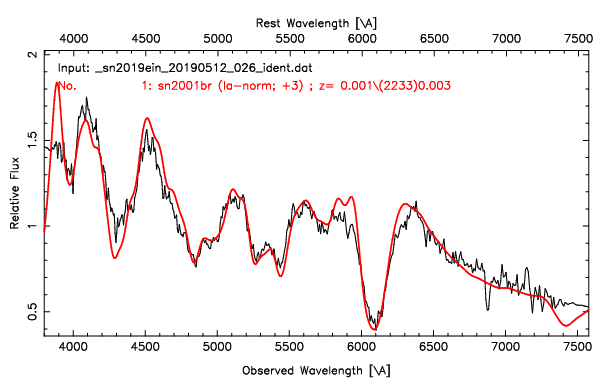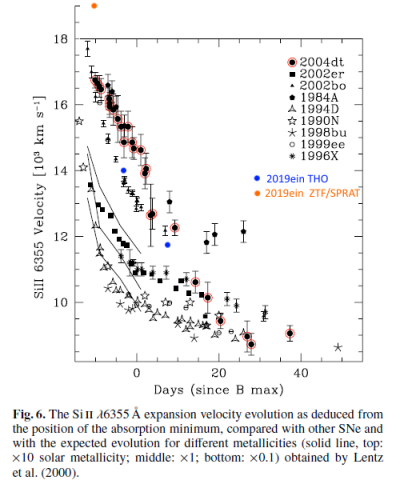› Forums › Spectroscopy › SN2019ein – an unusual supernova ?
- This topic has 6 replies, 2 voices, and was last updated 6 years, 7 months ago by
 Robin Leadbeater.
Robin Leadbeater.
-
AuthorPosts
-
3 May 2019 at 1:56 pm #574320
 Robin LeadbeaterParticipantDiscovered 20190501, apparently in NGC5353, the spectrum is reported to be unusual.Although from the spectrum it looks like a type Ia, the Doppler shift does not appear to match the host galaxy redshift and the explosion velocity is very high. It was discovered at mag 18.2 but had risen to mag 16.6 by this morning. I will try for it tonight with the ALPY 200 if it is clear but a normal type Ia in NGC5353 would be expected to reach ~mag 13 in the absence of extinction so could come into range of an ALPY 600/LISA/Star Analyser etc for example. Could be one to watch !Robin9 May 2019 at 11:31 am #581045
Robin LeadbeaterParticipantDiscovered 20190501, apparently in NGC5353, the spectrum is reported to be unusual.Although from the spectrum it looks like a type Ia, the Doppler shift does not appear to match the host galaxy redshift and the explosion velocity is very high. It was discovered at mag 18.2 but had risen to mag 16.6 by this morning. I will try for it tonight with the ALPY 200 if it is clear but a normal type Ia in NGC5353 would be expected to reach ~mag 13 in the absence of extinction so could come into range of an ALPY 600/LISA/Star Analyser etc for example. Could be one to watch !Robin9 May 2019 at 11:31 am #581045 Robin LeadbeaterParticipant
Robin LeadbeaterParticipantNow reported mag 13.5
13 May 2019 at 3:01 pm #581053 Robin LeadbeaterParticipant
Robin LeadbeaterParticipantAt last some decent clear skies !
An ALPY 600 spectrum from 20190511 (black) overlaid on the best fit from SNID (red). A typical type Ia near maximum
Robin
 13 May 2019 at 3:59 pm #581054
13 May 2019 at 3:59 pm #581054 Dr Andrew SmithParticipant
Dr Andrew SmithParticipantNice clean spectrum Robin. So not so unusual as first thought. Foreground star?
Regards Andrew
13 May 2019 at 5:50 pm #581055 Robin LeadbeaterParticipant
Robin LeadbeaterParticipantAssuming it does not get any brighter, the magnitude is about right for a Ia at the distance of NGC5353, perhaps a little faint but I think it is particularly tricky to measure redshift from Ia supernova spectra. Unlike type II where at least you have H alpha emission unshifted by the explosion velocity, you just have broad absorption lines blue shifted by the explosion, the velocity of which reduces with time. If I understand correctly how SNID for example estimates the age and redshift, it attempts to simultaneously fit these two parameters, comparing with other spectra in the library. It can be significantly out at times though. It is possible that the explosion velocity is higher than usual as suggested by the original classifiers, which could then throw out the redshift estimate. Also the published redshift of NGC5353 is probably for the nucleus and this SN is in the outer regions where the radial velocity might be different. The light curve should eventually give the age though which perhaps will pin things down better.
Cheers
Robin
22 May 2019 at 2:19 pm #581068 Robin LeadbeaterParticipant
Robin LeadbeaterParticipantIt looks like maximum (g mag) was reached 2019-05-15 according to the ASAS-SN light curve
https://asas-sn.osu.edu/light_curves/078780dd-d80f-495e-95d6-d32d31ed2523
24 May 2019 at 9:31 am #581072 Robin LeadbeaterParticipant
Robin LeadbeaterParticipantNow we have the date for maximum, we can compare the velocity in the Si II 6355 line with other type Ia supernovae. It does appear this one is indeed towards the high end, similar to sn2002bo for example.

Robin
-
AuthorPosts
- You must be logged in to reply to this topic.
